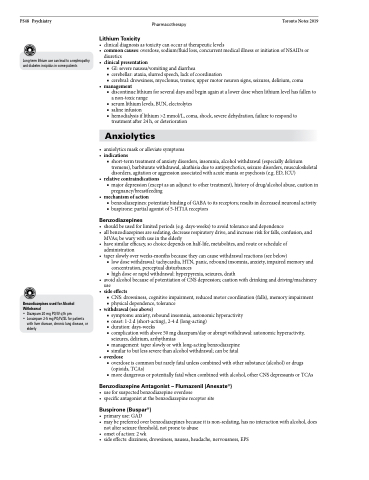Page 1212 - TNFlipTest
P. 1212
PS48 Psychiatry
Pharmacotherapy Toronto Notes 2019
Long-term lithium use can lead to a nephropathy and diabetes insipidus in some patients
Lithium Toxicity
• clinicaldiagnosisastoxicitycanoccurattherapeuticlevels
• commoncauses:overdose,sodium/fluidloss,concurrentmedicalillnessorinitiationofNSAIDsor
diuretics
• clinicalpresentation
■ GI: severe nausea/vomiting and diarrhea
■ cerebellar: ataxia, slurred speech, lack of coordination
■ cerebral: drowsiness, myoclonus, tremor, upper motor neuron signs, seizures, delirium, coma
• management
■ discontinue lithium for several days and begin again at a lower dose when lithium level has fallen to a non-toxic range
■ serum lithium levels, BUN, electrolytes
■ saline infusion
■ hemodialysis if lithium >2 mmol/L, coma, shock, severe dehydration, failure to respond to
treatment after 24 h, or deterioration
Anxiolytics
• anxiolyticsmaskoralleviatesymptoms
• indications
■ short-term treatment of anxiety disorders, insomnia, alcohol withdrawal (especially delirium tremens), barbiturate withdrawal, akathisia due to antipsychotics, seizure disorders, musculoskeletal disorders, agitation or aggression associated with acute mania or psychosis (e.g. ED, ICU)
• relativecontraindications
■ major depression (except as an adjunct to other treatment), history of drug/alcohol abuse, caution in pregnancy/breastfeeding
• mechanismofaction
■ benzodiazepines: potentiate binding of GABA to its receptors; results in decreased neuronal activity ■ buspirone: partial agonist of 5-HT1A receptors
Benzodiazepines
• shouldbeusedforlimitedperiods(e.g.days-weeks)toavoidtoleranceanddependence
• allbenzodiazepinesaresedating,decreaserespiratorydrive,andincreaseriskforfalls,confusion,and
MVAs; be wary with use in the elderly
• havesimilarefficacy,sochoicedependsonhalf-life,metabolites,androuteorscheduleof
administration
• taperslowlyoverweeks-monthsbecausetheycancausewithdrawalreactions(seebelow)
■ low dose withdrawal: tachycardia, HTN, panic, rebound insomnia, anxiety, impaired memory and concentration, perceptual disturbances
■ high dose or rapid withdrawal: hyperpyrexia, seizures, death
• avoidalcoholbecauseofpotentiationofCNSdepression;cautionwithdrinkinganddriving/machinery
use
• sideeffects
■ CNS: drowsiness, cognitive impairment, reduced motor coordination (falls), memory impairment
■ physical dependence, tolerance
• withdrawal(seeabove)
■ symptoms: anxiety, rebound insomnia, autonomic hyperactivity
■ onset: 1-2 d (short-acting), 2-4 d (long-acting)
■ duration: days-weeks
■ complication with above 50 mg diazepam/day or abrupt withdrawal: autonomic hyperactivity,
seizures, delirium, arrhythmias
■ management: taper slowly or with long-acting benzodiazepine ■ similar to but less severe than alcohol withdrawal; can be fatal
• overdose
■ overdose is common but rarely fatal unless combined with other substance (alcohol) or drugs (opioids, TCAs)
■ more dangerous or potentially fatal when combined with alcohol, other CNS depressants or TCAs
Benzodiazepine Antagonist – Flumazenil (Anexate®)
• useforsuspectedbenzodiazepineoverdose
• specificantagonistatthebenzodiazepinereceptorsite
Buspirone (Buspar®)
• primaryuse:GAD
• maybepreferredoverbenzodiazepinesbecauseitisnon-sedating,hasnointeractionwithalcohol,does
not alter seizure threshold, not prone to abuse
• onsetofaction:2wk
• sideeffects:dizziness,drowsiness,nausea,headache,nervousness,EPS
Benzodiazepines used for Alcohol Withdrawal
• Diazepam 20 mg PO/IV q1h prn
• Lorazepam 2-5 mg PO/IV/SL for patients
with liver disease, chronic lung disease, or elderly


